Paul Gibson was in the car on a hot July day last year, making the 3 1/2-hour trek from Springdale, Ark., where the Royals’ Double-A team plays, to Kansas City. The Royals’ senior pitching director was deep in thought.
Things were going sideways on the farm, specifically in Double-A, where the Royals had a host of top pitching prospects. Alec Marsh, Jonathan Bowlan and Anthony Veneziano were struggling. Will Klein and Christian Chamberlain couldn’t get right after their early-season injuries, and Asa Lacy couldn’t shake the injury bug -- he still hasn’t.
On the road that day, Gibson was trying to figure out how to get the Royals’ pitching development on track.
“We needed to make some adjustments,” Gibson said. “And it wasn’t just in Double-A, it was all over.”
The Royals struggled last season throughout the entire system. Key pitchers did not take steps forward. Players were frustrated, and officials searched for answers.
As a small-market team trying to win at the Major League level, the Royals must have a unique blend of homegrown talent and acquisitions to supplement the core. But even beyond this seven-year (and counting) rebuild, there are deep-rooted problems in pitching development. Kansas City has not drafted and developed a 10-WAR pitcher since it selected Danny Duffy in 2007. In the 2018 Draft, the Royals went heavy on college pitchers, taking four -- Brady Singer, Jackson Kowar, Daniel Lynch and Kris Bubic -- in the top 40 picks to fast-track their rebuild. All four have debuted in the Majors, along with Austin Cox and Jonathan Heasley from that Draft, a milestone for the organization.
But it hasn’t been easy. Those six pitchers have a combined 6.8 wins above replacement, per Baseball Reference. That’s 3.6 WAR less than Zack Greinke’s Cy Young Award-winning season for the Royals in 2009.
Kansas City has work to do to identify and develop the right players to help it win at the Major League level.
“It’s not a quick fix,” chairman and CEO John Sherman said. “We’ve always said that pitching is the key to this. Making sure we’re evaluating, acquiring and developing pitching talent certainly is a priority.”
Gibson, an eight-year MLB veteran turned respected pitching coach, recognizes how important steering this ship is; behind the wheel last season, he knew change needed to happen.
It’s a slow process and sometimes a frustrating one. But this year, in the Minor Leagues, there have been signs of progress.
At the All-Star break, five Royals pitchers ranked in the top 100 of all Minor League pitchers (minimum 30 innings) in strikeout percentage and strikeout-to-walk percentage; six rank in the top 100 in swinging-strike percentage. In 2022, Kansas City had just one pitcher -- Noah Cameron -- rank in the top 100 (minimum 60 innings) in strikeout percentage and strikeout-to-walk percentage. The Royals have seen improvements across the board in what they call key performance indicators -- ERA, WHIP, hard-hit percentage, first-pitch strike percentage and more.
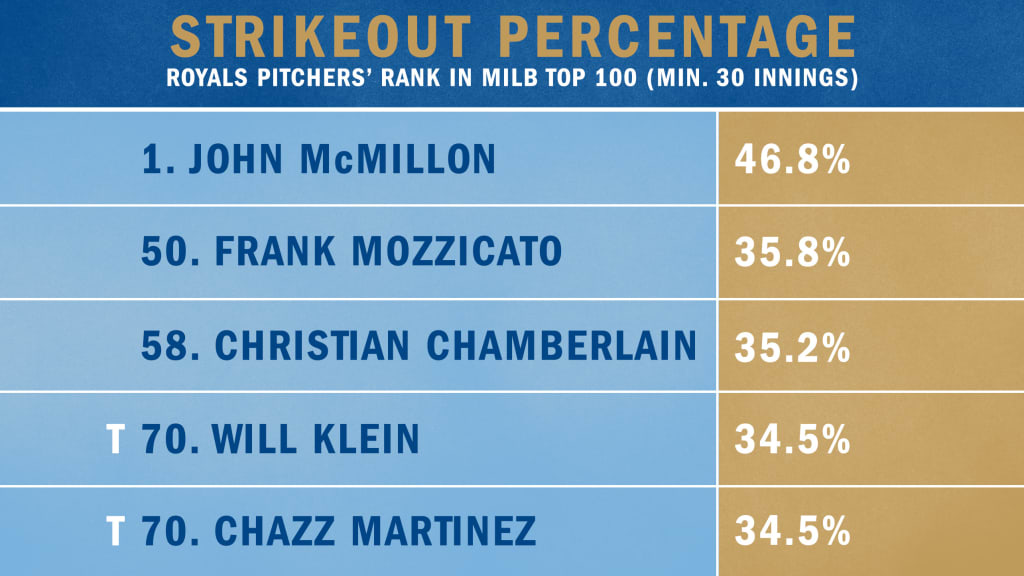
“It’s been remarkable,” Gibson said. “The numbers are encouraging. On the individual front, I can’t even begin to count how many guys are in a better space than they were last year. Some of that is injury. Some of that, I go back to preparation, routines and communication.”
The turnaround started with Gibson and a 25-year-old former-pitcher-turned-coach, who helped spearhead highly specific plans for each individual pitcher, built around personalized pitch selection, grips, delivery and location. The Royals paired that with workout regimens and warmup routines designed to bring those skills onto the mound.
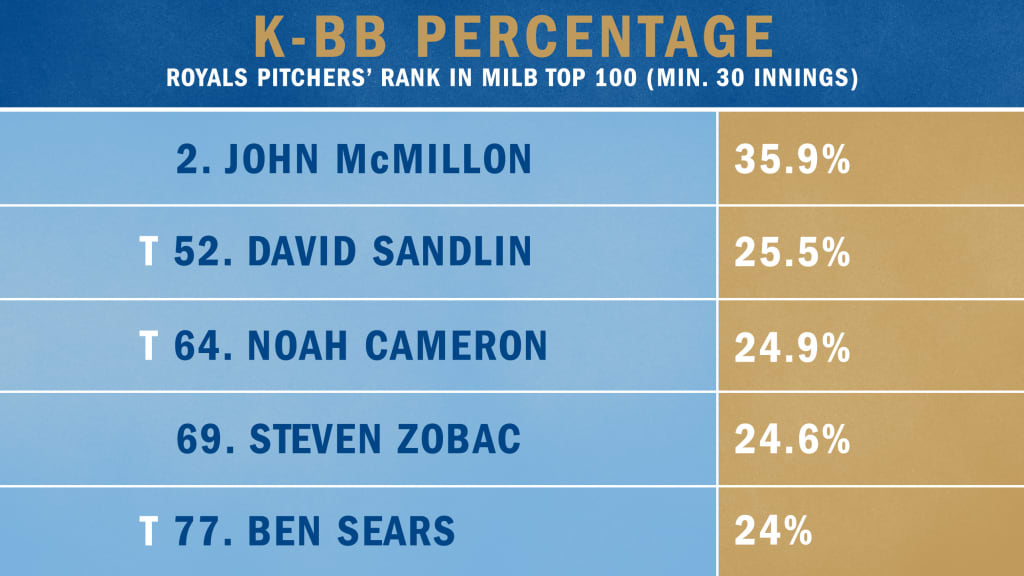
The work isn’t done, but in reviewing the processes, the Royals are optimistic about where their development is going.
Detailed plans drive offseason
In early March, under the sunny-yet-windy skies in Surprise, Ariz., Royals Minor Leaguers convened for the start of Spring Training. Excitement filled the air like every spring, but something about the vibe was different.
Jay-Z bumped from a big speaker behind the eight-pitcher bullpen mound, an area that is typically quiet as pitchers begin to throw. Players laughed and talked as they warmed up. In the middle of it all was Justin Friedman, the Royals’ assistant director of pitching performance/strategist. At 25 years old, Friedman looks like a player until you notice that day’s pitching schedule sticking out from his back pocket and a bag of baseballs in one hand, ready to help the next player who needs it.
Part of Gibson’s reflection last season had him thinking about the pitching development staff. Especially Friedman, who had been hired in 2022 to join the Triple-A staff in Gibson’s push to bring new ideas and perspectives to the organization. There, Friedman connected with players right away.
“He’s one of the smartest people I’ve met,” Cox said during the spring. “He definitely has a really good understanding of the analytics, the way the body moves and how it all connects. … He was all on board with integrating it together with actual pitching.”
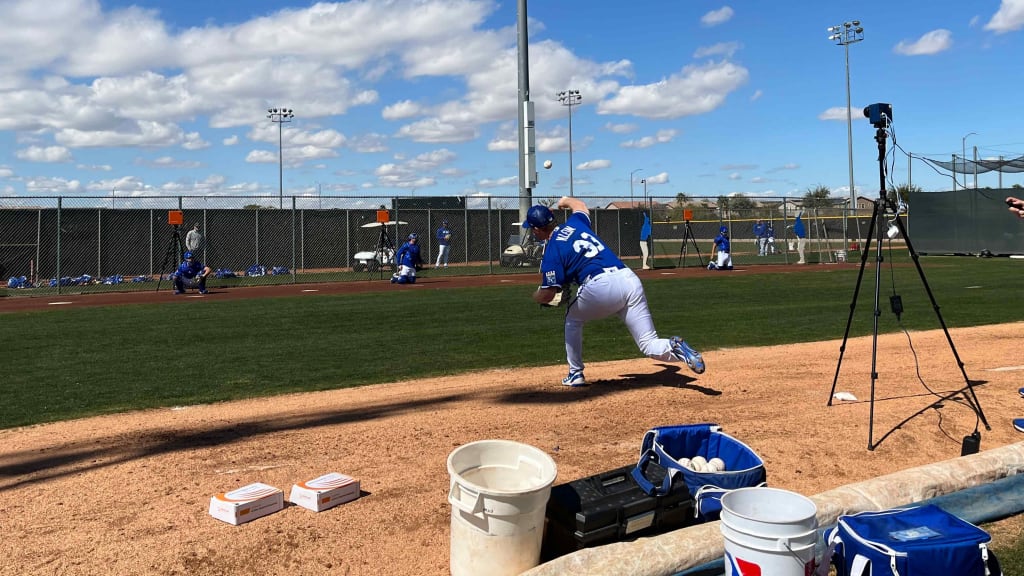
After being released by the White Sox in 2020, Friedman retired from pitching. He took a job at Rockland Peak Performance -- a training facility for high school, college and professional players in New Jersey -- overseeing throwing programs and helping with pitching analysis.
He has always had an eye for the anatomical and analytical side of pitching. As a coach, he enjoys getting the best out of players using those guardrails.
“Even in my own experience, it’s such a small window of opportunity,” Friedman said. “Getting to the best version of you as fast as possible and as efficiently as possible is paramount.”
As Gibson observed the way Friedman thought and coached, he realized Friedman could be valuable at a larger scale.
“He needed to get at our grassroots and help us build this out,” Gibson said.
Friedman headed to Arizona, where he and then-manager of pitching performance Mitch Stetter -- now Kansas City's bullpen coach -- worked countless hours with several departments to build individualized player plans for the offseason. These included a pitcher’s delivery, movement, arsenal, grips, splits, locations -- the Royals looked at it all, and together with the player, they created a detailed plan for the offseason.
“Essentially, running diagnostics using all our different departments,” Friedman said. “... We looked at the potential limiting factors for each guy and then made sure that we got those out of the way to allow them to realize the potential we see for them.”
At the beginning of the offseason, each player received a goal sheet telling them what their pitches looked like in 2022 and what steps they needed to take in ’23.
Veneziano’s report, for example, detailed mechanical problems and graded his pitches. His fastball and changeup needed major work, while the Royals thought he should throw his slider more. Klein suggested adding a slider back into his repertoire, and he sent data and video from his training facility in St. Louis to Friedman and the organization as he worked on it through the offseason.
“They gave me a good program this offseason, lifting-wise and throwing-wise, so that was huge,” Klein said. “Having a little more analytical advice from them really helped.”
Each player report looked different, individualized to them and their profile. No longer are the Royals using a blanket pitch-usage philosophy, general manager J.J. Picollo said. There is a better understanding of a player’s pitch characteristics -- emphasizing the pitches that fit the pitcher -- while they’re trying to integrate movement patterns better than before.
“We’ve adapted to understanding what a pitcher wants to do and what his pitches are telling us he can do,” Picollo said. “It’s coming together more nicely now. We have a better balance of people to communicate with any type of player.”
Numbers drive that communication as much as a player wants.

“Everybody receives information differently, and it calls on us to be highly adaptable in how we deliver the information,” Friedman said. “To be able to adapt and package accordingly, but also being prepared that if they do want to know more, you have a clear ‘why’ and a data-driven approach behind, ‘Here’s why you have this exercise.’”
The players embraced the reports that helped them guide their training. Veneziano said it “took the pressure off” this offseason. Cox said it gave him tangible goals to work toward.
“I think it’s a night-and-day difference between years prior and the new pitching development we have,” Marsh said. “Justin Friedman and all those guys have done a great job. Especially in season, which I was kind of surprised about, we’re changing stuff from week to week, whether it be weightlifting or accessory work on the mound or working on and tweaking pitches. It’s definitely a huge difference.”
It's all in the preparation
While the pitching staff worked on individualizing training for each pitcher, it also met with different departments in Arizona about what else the Royals could do to help their pitchers in 2023.
They embraced a practice called movement preparation, drills that are common around modern baseball now as players learn what works best for them to get ready to throw. In Spring Training, before pitchers threw, they gathered around colorful equipment, including weighted balls, velocity belts and medicine balls.
Each pitcher is armed with drills that activate key muscles needed to throw before they start their warmup, and these drills target movements a pitcher might need to improve his delivery. Kansas City’s strength and conditioning department worked closely with the pitching department in the offseason and early spring to identify what movements could help a pitcher improve. For example, a player who is falling down the mound in his delivery might have weak hamstrings, or a player’s arm path as they release the ball might need smoothing out.
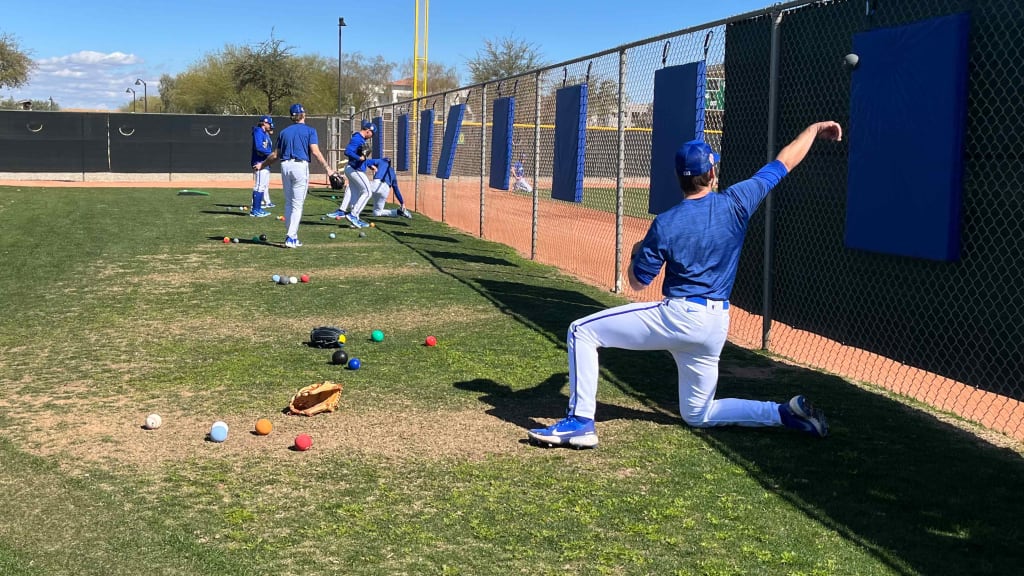
There are exercises to help, and making them a part of a player’s routine establishes a more narrowed focus on improving performance and reducing injuries.
“We asked, ‘Where can we do better? What can we provide to help every single player instead of as a whole?’” Minor League strength and conditioning coordinator Jarrett Abell said. “Trying to think of guys as individuals as opposed to a group philosophy.
“If there’s a movement that we’re trying to get them to make on the mound, feeling that before you’re in that setting -- where you’re dealing with years of habit, muscle memory, where execution matters -- that’s where we can instruct.”
The Royals did not force pitchers to do movement prep this spring, but by the end, most were participating in drills. A year ago, Veneziano was fumbling through Double-A, unsure about his mechanics every time he stepped onto the mound, leading to a 5.72 ERA in 26 games (25 starts). Thanks to drills he began this offseason, Veneziano got his delivery back in sync. He returned to Double-A in 2023 and posted a 9.60 strikeout-to-walk ratio with a 2.13 ERA over eight starts before he was promoted to Triple-A on May 19.
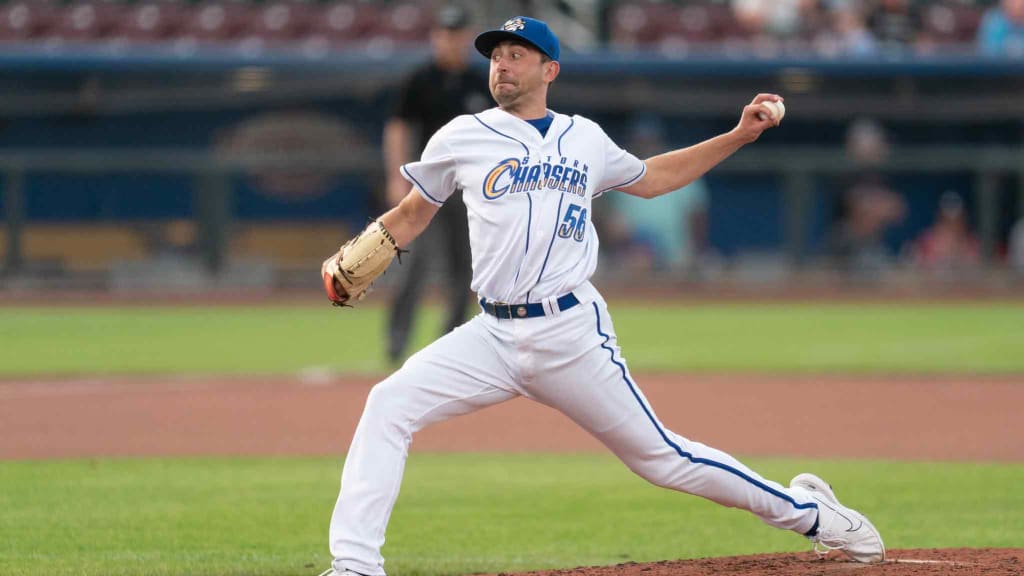
“The biggest thing is getting my arm on time. I cleaned up my arm path by doing some of the weighted-ball stuff,” Veneziano said. “And in my lower half, I can actually feel the first move of me getting down the mound instead of jumping forward. I think these drills translate to the game, so I’m not thinking as much out there.”
In Surprise back in March, the music was loud. The atmosphere was relaxed as pitchers were loosening their bodies. When bullpen sessions started, collaboration was evident, from players to coaches and analysts.
There is still a long way to go to fix the Royals’ pitching problems. But there is a difference in this group of Minor League pitchers. It was noticeable from the start.
“The energy is different,” Veneziano said then. “The plans are a little bit more hand-in-hand with what I think. From Day 1, I just felt the confidence [coaches] have in me. And that gives me the confidence to believe that I’m good.”
